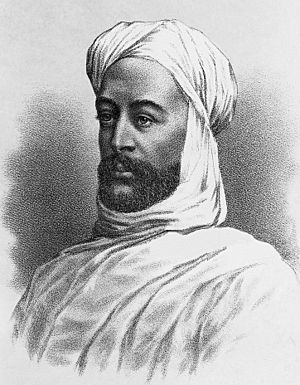Muhammed Ahmed facts for kids
Quick facts for kids Muhammad Ahmad al-Mahdi |
|||||
|---|---|---|---|---|---|
| Ruler of Sudan | |||||

Artistic representation of Muhammad Ahmad al-Mahdi.
|
|||||
| Reign | 1881-1885 | ||||
| Successor | Abdallahi ibn Muhammad 'Khalifa' | ||||
| Born | August 12, 1844 Labab Island, Dongola |
||||
| Died | June 22, 1885 (aged 40) Khartoum, Sudan |
||||
| Burial | Omdurman, Sudan | ||||
|
|||||
| Religion | Islam | ||||
Muhammad Ahmad bin Abd Allah (born August 12, 1845 – died June 22, 1885) was an important religious leader in Sudan. He belonged to a group called the Sufi Samaniyya order. On June 29, 1881, he announced that he was the Mahdi. In Islam, the Mahdi is a special leader who will come to make the world fair and just.
At this time, many people in Sudan were unhappy. They disliked the rulers from Turkey and Egypt, who were in charge of Sudan. These rulers were seen as unfair and harsh.
People in Sudan had many different religious beliefs. There were ideas about a "Mahdi" coming to save them. Other Islamic movements were also happening, trying to bring back purer forms of the faith. This was partly because European countries were becoming very powerful in the 1800s.
The British government also had a lot of influence in Sudan. They saw Sudan as a "Joint Anglo-Egyptian Condominium," meaning it was ruled by both Britain and Egypt. The British supported the Egyptian rulers, known as the Khedives. When Muhammad Ahmad declared himself the Mahdi, the British sent their forces to Sudan. General Charles George Gordon was made Governor General of Sudan. He later died in Khartoum fighting against the Mahdi's army.
From 1881 to 1885, Muhammad Ahmad led a successful fight against the Turco-Egyptian government in Sudan. The fighting stopped when General Gordon was killed in Khartoum. Muhammad Ahmad died unexpectedly on June 22, 1885, just six months after taking Khartoum. His main helper then took over the rule of Sudan.
What Happened After the Mahdi's Rule?
The Mahdist rule in Sudan was very hard on its people. The country's economy was almost completely ruined. About half of the population died because of hunger, sickness, and fighting. Millions of people in Sudan lost their lives during this time.
Many of the country's old ways and groups were broken apart. Different tribes had disagreed about supporting the Mahdi. Religious groups were weakened, and many traditional religious leaders disappeared.
British Forces Reclaim Sudan
In 1895, the British Government decided to take back Sudan. They asked Herbert Kitchener to lead the campaign. Britain provided soldiers and equipment, and Egypt paid for the mission. The Anglo-Egyptian Nile Expeditionary Force had 25,800 men. About 8,600 of these were British soldiers. The rest were Egyptian troops, including some from southern Sudan.
The army had boats with guns on the river and powerful artillery (large guns). To get ready, the British set up their main army base at Wadi Halfa. The campaign began in March 1896. By September, Kitchener had captured Dunqulah. The British then built a railway line to move troops and supplies faster.
On September 2, 1898, a big battle happened in Omdurman. The Sudanese leader, now called the Khalifa, led his army of 52,000 men. They attacked the Anglo-Egyptian force, which was waiting outside the town. The British had much better weapons, so the outcome was clear. In five hours, about 11,000 Mahdist fighters died. The Anglo-Egyptian side lost only 48 soldiers and had fewer than 400 wounded.
It took a few more years to fully stop all resistance. The Khalifa escaped but was killed in battle in November 1899. Many areas of Sudan were happy when his rule ended.

